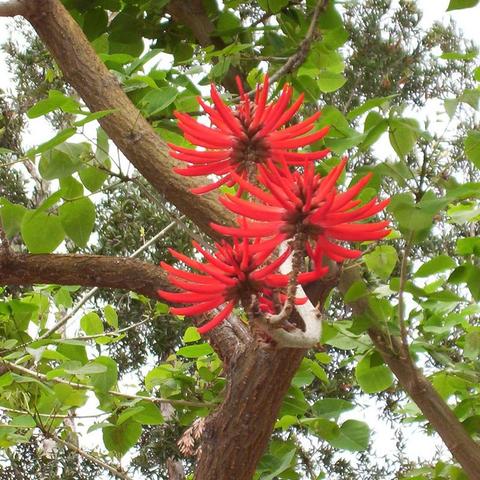- DOI:10.4236/ajps.2014.55068
- accepted 23 February 2014
Ana Maria Soares Pereira1*, Verena Trevizani Alves Souza1, Juliana da Silva Coppede1, Suzelei de Castro França1, Bianca Waléria Bertoni1, Ana Valéria Vieira de Souza2
1Department of Biotechnology, University of Ribeirão Preto, Ribeirão Preto, Brazil
2Embrapa Semiárido, Centro de Pesquisa Agropecuaria do Tropico Semi-Arido, Petrolina, Brazi
Species of the genus Erythrina are frequently used as ornamental plants and in projects to restore degraded areas. Also, extracts from its shoots and stems are popularly used as a herbal medicine with validated activity on the central nervous system. The objective of this study was to evaluate E. mulungu and E. velutina seed germination and seedling development potential aiming commercial scale production of those species. Seeds stored for one or twelve months at 10˚C ± 2˚C were sown in sand, soil or Plantmax® substrates and evaluated for germination and seedling development. Subsequently, seedlings sprouted in Plantmax® were transferred to polyethylene bags and kept in greenhouse, under direct sunlight for plant development (plant height, stem diameter and root length pivoting) evaluations. Four-month-old plantlets were transplanted to the field and after a period of one year the collar diameter and shoot height (of each plant were measured. Seed germination rates of both species grown in soil and in Plantmax® were significantly high (over 80%). Storing seeds for 1 month did not inhibit germination. However, seeds stored for twelve months had germination reduced by more than a quarter. The development of plants in greenhouse and in the field was satisfactory, indicating the viability of producing E. mulungu and E. velutina on a commercial scale, in order to meet the expanding market demand for herbal medicines.
Keywords:Medicinal Plants; Herbal Medicines; Cerrado; Caatinga; Rhizobium
The plant genus Erythrina [Leguminosae—Papilionoideae (Fabaceae)] comprises approximately 115 species distributed all around the Neotropics, across South Africa, and all over the Himalayas and southern United States [1] .
In Brazil, the most customarily found species are Erythrina velutina Willd. and Erythrina mulungu Mart. Ex Benth., which are well known for their multipurpose use. Those species are used as ornamental plants. Because of its deep pivoting root system and rapid growth, it is also used in the restoration of degraded areas and in riparian vegetation recovery. Erythrina is considered a pioneer species in ecological succession [2] -[5] . The sedative action of the Erythrina tea that is popularly consumed in Brazil has been reported in ethnobotanical studies [6] [7] . Moreover, numerous pharmacological studies carried out with animals validated the anxiolytic, anticonvulsant and antinociceptive effects of the hydroalcoholic extract of E. velutina and E. mulungu stem bark and flowers [8] -[17]
However, even being a species relevant to the development of scientific researches, especially considering its diversity of use and validated therapeutic efficacy, only a few studies on Erythrina seed germination characteristics and production of seedlings have been carried out and those works are restricted to seed physical dormancy caused by its water-impermeable seed coat [18] -[21] .
In view of the importance of studies aiming the large scale production of Erythrina species for further establishment of sustainable management and production of plantlets with commercial purposes, in this work the germination potential of E. mulungu and E. velutina seeds and plant development in greenhouse and in field conditions were evaluated in order to achieve this plant mass production and enable its use in flora recovery programs and also to provide crude material for the development of phytopharmaceutical formulations.
Reference:
https://www.scirp.org/html/3-2601203_43557.htm

